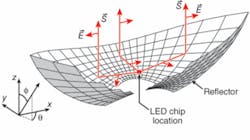Martin Schubert, a doctoral student in electrical, computer, and systems engineering at Rensselaer Polytechnic University (Troy, NY), won the $30,000 Lemelson-Rensselaer Student Prize (www.rpi.edu/lemelson) for his development of the first polarized light-emitting diode (LED), an innovation that could vastly improve liquid-crystal display (LCD) screens, conserve energy, and usher in the next generation of ultra-efficient LEDs.1
Schubert’s polarized LED advances current LED technology in its ability to better control the direction and polarization of the emitted light, wasting less energy to scattered light and allowing more light to reach its desired location.
The first step in the process of developing a polarized LED was to fully understand the polarization effects of a typical unpackaged LED chip. The side emission from a 460 nm LED consisting of gallium indium nitride (GaInN) epitaxial layers grown on (0001) sapphire substrates was measured for two polarizations—the polarization which lies in the plane of the quantum wells (in-plane polarization), and the polarization orthogonal to it (normal-to-plane polarization). One of the findings was that side emission was much stronger for in-plane polarized light; in fact, values for the ratio of in-plane polarized light to normal-to-plane polarized light were as high as 7:1.
This finding, combined with the understanding that conventional LED packaging uses rotationally symmetric reflector cups and encapsulants to perform ray mixing and averaging to produce unpolarized light, led Schubert to begin experimentation on how to exploit polarization for packaged LEDs. The result is an entirely new reflector design that varies the optical path based upon the direction of light emission from the LED: all light emitted by the LED that is incident on the reflector is directed upward (see figure). Depending upon the direction of the emitted light, the polarization can also be rotated by some angle such that it becomes polarized along a single direction when it leaves the reflector.
The reflector is fabricated from aluminum by a computer-controlled milling machine and then extensively polished by hand to give the surface a specular optical finish. A slot is machined in the center at the bottom in order to facilitate mounting of the LED chip.
Polarized light directed upward
Experimental results show that by using this reflector design, the in-plane polarized side-emitted light is directed upward with a single dominant linear polarization. Polarization ratios as high as 3.5:1 are measured in the far field, and the average polarization ratio is 1.9:1. If only light that strikes the reflector is considered, the polarization ratio is 2.5:1. “Because LCDs operate using polarized light, having a backlight which directly produces polarized light could be beneficial,” says Schubert. “In such an application, if an unpolarized light source is used in combination with a polarizer, 50% of light produced would be wasted. If the light source is completely polarized, there is no waste, and efficiency is increased by 100%. Our prototype polarized LEDs aren’t completely polarized, but they do show polarization ratios as high as 3.5:1, which would give an efficiency increase of over 50%.”
“In our community of innovators, the Lemelson-Rensselaer Student Prize recognizes our most inspired and dedicated students for their ingenuity and deep understanding of the greater global implications of their innovations,” says Shirley Ann Jackson, Rensselaer president. “Martin Schubert is both a talented engineer and inspired entrepreneur. He launched his innovation not only because he had the engineering prowess, but because he also has a remarkable understanding of the technological, environmental, and energy-saving outcomes his enlightened innovation will bring.”
REFERENCE
1. http://news.rpi.edu/update.do?artcenterkey=2406 (Feb. 28, 2008).

